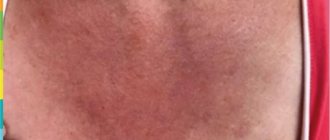How to cauterize papilloma at home is a pressing question among people who have noticed formations on the skin that have arisen as a result of HPV infection. The desire to get rid of growths on your own is explained by the lack of time to visit the hospital and lack of funds for the removal procedure. It is not advisable to risk your health; some types of papillomas can only be removed by a doctor.
What are moles? What are they?
To answer this question, you must first clarify what we mean by the word “mole.” An ordinary person can easily find several types of skin formations. Brown, red, flesh-colored - all these can be called moles. In fact, the World Health Organization (WHO) classification of benign skin lesions includes about 150 names. And all this diversity can also be called moles. Read a little more about the most common types of moles here.
As we said above, there are a huge number of types of moles. Today we will talk about those that are most common and, theoretically, can pose the greatest danger - brown and flesh-colored moles.
Where to remove a mole, polyp, condylomas, papilloma or wart in St. Petersburg
At the Diana St. Petersburg Medical Center, all methods of removing tumors are used, but preference is given to modern laser and radio wave techniques. The clinic has the latest radio wave apparatus. Treatment is carried out without pain and complications under ideal sterile conditions.
Here you can take tests for oncology and blood clotting, undergo all types of ultrasound, get advice from a urologist, gynecologist, dermatologist and oncologist. All doctors have the highest qualification category and extensive experience.
Brown moles
Such moles are a cluster of nevus cells. These cells are very similar to melanocytes and, like them, produce the pigment melanin. This pigment is brown in color, which makes our skin darker if there is a lot of it and lighter if there is not enough of it. Its production also increases after prolonged exposure to the sun.
Melanocytes and nevus cells
Melanocytes and nevus cells have certain differences, which we will not delve into. Let’s just note that brown moles most often consist of nevus cells. It is nevus cells that can turn into melanoma cells - one of the most malignant human tumors (more about it here)
Traditional methods of tumor removal: painful, dangerous and ugly
Surgical
– the doctor, under local anesthesia, excises the formation and sutures the skin. The procedure takes 30 minutes or more. After the stitches are removed, scars and even serious scars remain, which are not always “erased” by skin polishing.
The surgical method of removing tumors is positioned as simple and cheap. But, if you consider the amount that you have to pay to get rid of scars, you can argue with such a statement. After surgical removal of several formations, the costs of eliminating the consequences will be considerable, not counting the time spent on restorative procedures.
Electrocoagulation
- a method of removing formations from the skin and mucous membranes using high voltage current. Electricity is supplied through a metal loop, so the procedure is reminiscent of wood burning.
After local anesthesia, a mole, papilloma or wart is “burned” by electric current, and in its place a scab is formed - a crust, under which tissue healing occurs within 10-14 days.
Although the electrocoagulation method is preferable to the surgical one, it is also not without its drawbacks.
- Does not allow you to control the depth of current penetration
, so there is a high risk of cauterizing the tissue too deeply; After the procedure, a whitish scar remains, noticeable against the general background of darker skin. It's difficult to get rid of it. - Weak selectivity
. When cauterized, healthy tissues are damaged. The doctor can “overdo it”, taking too much of the surrounding skin, and a keloid scar remains on the body, and even worse, on the face after healing.
The use of electrical destruction in the treatment of cervical erosion leads to the formation of scar tissue, which interferes with the opening of the cervix during childbirth and provokes ruptures.
Why can mole removal be dangerous?
If you have already read about moles on the Internet, then you have probably already found information that “after removing moles, you can die from cancer.” I discuss this topic in detail in this article. Now I will say that such cases really do happen. This happens when a doctor removes a malignant tumor, which he considered an ordinary mole, and does not send it for histological examination. After this, indeed, melanoma can very quickly develop at the site of removal and this can cause death.
Briefly about the main thing:
If you decide to get rid of papillomas, there are 2 ways: The first is to remove papillomas in the clinic, preferably from an oncologist. The advantages of this method are obvious - maximum efficiency and safety. The second method is removal at home using drugs that can be bought in pharmacies. The advantage of this method is its low cost, however, for safe removal, I recommend first consulting with an oncologist. If treatment of papillomas with none of the above methods is effective, it is worth checking your immunity. To do this, it is better to consult an immunologist.
Have you decided to part with your papillomas? This can be done at addresses in St. Petersburg (Asafieva 7/1)
Reasons for removing moles
In my opinion, there are 4 reasons to remove moles:
- The mole raises doubts about its benign quality among the oncologist. In this situation, we will not be talking about removing a mole, but about a biopsy of a possible malignant tumor. Subsequent histological examination will show whether a larger operation is needed or not.
- The mole is subject to regular trauma. This can happen when playing sports, shaving, during work, when a mole is located on the belt or bra line, as well as in a hairdresser. Regular traumatization of a mole, especially to the point of bleeding, may be one of the risk factors for the development of melanoma.
- A mole causes a cosmetic defect. No explanation needed here. The issue of beauty is very individual for each person and there are no clear rules here.
- A mole causes obsessive thoughts about its transformation into cancer or melanoma (oncophobia). As a rule, this happens after a long time of independently studying the Internet on the topic of melanoma and skin cancer. Sleep and appetite are disturbed, neurosis sets in, because if you want, you can find confirmation of anything on the Internet. Not only that “this mole I have is definitely melanoma,” but also that “Lenin is a mushroom.” In this situation, removal of the mole is necessary only to restore lost psychological comfort.
In the latter case, it is important to combine deletion with stopping independent study of the World Wide Web on the topic of skin cancer and melanoma.
How to get rid of papillomas?
There are only two main methods of treating papillomas
- The simplest and most effective method of treatment is the removal of papillomas using various methods ( laser, radio wave surgery, electrocoagulation
, etc.). In most cases, a one-time complete removal of papillomas from the entire body is sufficient. I will tell you in more detail about how papillomas are removed using radio wave surgery in our clinic below. - Removing papillomas at home
has recently become a very popular method . Most often, this happens with the help of two types of drugs - acid solutions with names like “Super Celandine” and a mixture of dimethyl ether and propane (the popular drug “Cryopharma”). I can’t say anything about the effectiveness of these two methods, because... I have never removed papillomas this way.
IMPORTANT!!!!
Please do not diagnose yourself with papilloma based on research on the Internet. Before using the above drugs, you should always see an oncologist and make sure that what you are going to remove at home is really a papilloma. If the diagnosis is made incorrectly and any of these liquids are applied to the pigmented nevus, the consequences can be extremely sad.
Contraindications for laser removal of papillomas
Laser procedures are not performed under the following conditions:
- oncological diseases of any localization;
- HIV, MSID, viral hepatitis, diabetes mellitus;
- pregnancy and lactation;
- exacerbation of chronic diseases;
- infectious or inflammatory diseases;
- mental disorders;
- severe damage to the heart and lungs;
- organ failure;
- bleeding disorders;
- skin photosensitivity;
- autoimmune systemic diseases;
- inflammatory skin diseases, exacerbation of herpes infection.
Laser removal of papillomas and other skin formations can be performed in medical settings. The operations are carried out at a high professional level using modern laser technology of the latest generation, which eliminates the risk of complications or relapse. Removal of papillomas with a laser is carried out at any convenient time on an outpatient basis. After the intervention, you can go about your daily routine; it will not affect your usual lifestyle in any way. You can make an appointment by calling the center or leaving a request on the website.
Papilloma
Papilloma is a formation of connective tissue covered with stratified epithelium. There are different types - warts, senile papillomas, cutaneous horn, condylomas, etc.
Most often, papillomas are located on the skin, but can also occur on mucous membranes (for example, the oral cavity, larynx). Papillomas should be distinguished from skin cancer.
Papilloma on the skin is usually a small (2 to 15 mm in diameter) formation that rises above the surface of the skin in the form of a papilla; it can be flat or pedunculated. The epithelium covering the papilloma may have the form of papillae, sometimes the papillomas are covered with horny masses (keratopapilloma). If injured, they can bleed, and if they are large, they can ulcerate (photo below).
What studies can be prescribed for a patient with papillomas?
If a patient is diagnosed with papillomas, he is usually prescribed:
- Examination for the full range of sexually transmitted infections: syphilis and HIV, gonorrhea, trichomoniasis, chlamydia, genitourinary mycoplasmosis. This is necessary in the case of genital papillomas. To do this, the patient undergoes blood sampling from a vein and a smear examination for urogenital infections from the lower parts of the genitourinary tract (urethra, vagina, cervix).
- Blood test for sugar, cholesterol and lipid profile, bilirubin and transaminases. A clinical blood test can be offered to the patient to exclude those underlying diseases that served as a prerequisite for the presence of multiple papillomas on the skin or mucous membranes.
- Blood test for cryoglobulins - in case of suspected cryoglobulinemia before using the cryodestruction method.
Women with manifestations of genital HPV infection are prescribed a smear test for oncocytology and colposcopy - an examination of the condition of the cervical mucosa under a magnifying device (colposcope).
Features of papillomas
Papillomas can be of the following types: ordinary or vulgar warts, filiform (the most common type), flat, genital warts, plantar warts, juvenile warts. A dermatologist diagnoses and treats papillomas.
Most often, papillomas are localized in the armpits and inguinal folds, hands, on the surface of the foot, neck, under the mammary glands in women, as well as on the genitals. Papillomas located on the mucous membranes of internal organs are very dangerous; they can cause ulceration or bleeding. As a rule, papillomas that have a pronounced cosmetic defect are removed with a laser, i.e. which are located in open areas of the body, as well as those with a high risk of cancer.
Benefits of laser papillomas removal
Laser removal of papillomas has long been used to remove skin tumors, because this method has many advantages:
- Excellent result. Laser destruction removes the tumor completely, there is no risk of relapse.
- Minimum of unpleasant or painful sensations. The procedure is carried out using local anesthesia and there is no discomfort or pain.
- Speed of the procedure. Laser destruction of papillomas takes no more than 5 minutes to remove one tumor
- Minimal trauma. The laser beam has a directed effect and acts only on the cells of the formation, without affecting nearby tissues.
- No postoperative scars or scars. After laser removal, a small crust remains at the site of the papilloma, which disappears on its own within 1.5-2 weeks. New, intact skin appears at the site of formation.
- Versatility. Due to the precision of the laser, this method can be used on any part of the body, including areas with thin and sensitive skin, mucous membranes, intimate area, eyelid skin, etc.
- No rehabilitation period. The procedure is performed on an outpatient basis, after which you can lead your normal lifestyle.
- Minimal risk of postoperative bleeding. The action of the laser coagulates blood vessels, which eliminates the risk of bleeding.
Types of tumors caused by HPV
Not all clinical manifestations of papillomatosis are the same. Today, about 90 HPV strains have been typed and correlated with certain types of neoplasms. Based on the external manifestations of the disease, the following types of papillomas are distinguished:
- plantar papillomas, often called warts;
- simple, or vulgar, papillomas;
- flat papillomas;
- genital warts;
- filamentous papillomas.
Even a doctor cannot always make an accurate diagnosis based on appearance
Plantar warts
As the name suggests, plantar warts form on the skin of the feet and are characterized by internal growth, which distinguishes them from other types of neoplasms. They are usually solitary, but if left untreated they can reach impressive sizes, causing considerable discomfort.
Vulgar papillomas
Vulgar papillomas are also often called warts in everyday life. They grow from a small tubercle, gradually enlarging and darkening due to keratinization, and can merge with each other into formations of an indeterminate shape. Papillomas of this type are most often localized on the skin of the hands, less often on the knees, face, neck, and back. Like plantar pain, they can go away on their own.
Flat papillomas
Flat papillomas rise slightly above the skin, and their surface has a nodular structure. These neoplasms are not subject to keratinization (keratinization) of the surface, so they usually retain the color of healthy tissue or become slightly darker. They can appear on the face in the eye area and on the chin, as well as on the lower legs, arms, and back. A common symptom of vulgar papillomas is itching. Such neoplasms do not go away on their own, and an accurate diagnosis must be made by a doctor.
Condylomas acuminata
Genital warts are similar in appearance to cauliflower. Single neoplasms grow on a thin stalk, gradually merging with each other into large growths. Condylomas are localized in the anogenital area:
- on the external and internal genital organs;
- outside and inside the anus;
- in the perianal fold;
- in the urethra and bladder.
These neoplasms are precancerous and therefore must be removed, followed by subsequent therapy based on test results. Suffice it to say that in almost 80% of cases, cervical cancer is detected by this type of human papillomavirus.
Filiform papillomas
Filiform papillomas, otherwise called acrochords, grow on a thin stalk, which makes them easy to accidentally tear off, and are predominantly single, less often found in groups. Their main locations are the face in the area of the eyes and nose, inguinal folds, axillary areas and under the breasts in women. They usually have an oblong, elastic shape without keratinization. Rubbing with clothing can cause discomfort and damage. Acrochords cause mainly aesthetic discomfort and are susceptible to malignancy in rare cases.
An accurate diagnosis can be established using laboratory methods for studying tumors
Preparation and carrying out laser removal
Laser removal is preceded by a thorough examination and examination of the tumor. The doctor must be sure of its benign quality; in case of any doubts and the borderline state of the cells, laser technology is not used, but a surgical operation is performed.
During the procedure, under the influence of a laser, heating and layer-by-layer destruction of neoplasm cells occur, so it is impossible to take biological material for subsequent research. Additionally, the doctor surveys the patient about possible contraindications to the procedure, and also conducts a number of studies (blood tests).
No special preparation is required for the procedure. At the appointed time, the patient comes to the specialist, the operation includes the following stages:
- Disinfection of the surgical field.
- Conducting anesthesia (if necessary). For this, an injection, gel or spray is used.
- Installation of the device to the required laser length.
- Layer-by-layer evaporation of the neoplasm.
- Treat with an antiseptic and apply a bandage if necessary.
To avoid relapse of the disease, it is necessary to carry out antiviral therapy, as well as take immunomodulating and immunostimulating drugs to strengthen the immune system.
Pharmacy preparations for freezing tumors
A doctor must remove moles. You cannot do this on your own. Otherwise, you can provoke a malignant degeneration of the nevus. You can remove papillomas yourself. Provided that the doctor has previously examined the patient and confirmed the diagnosis. And also approved the method of treatment. To do this, you can purchase a remedy for papillomas at the pharmacy, which freezes tumors. The most effective drugs include:
- "Wartner Cryo". Removes not only papillomas, but also warts. The active ingredient of the drug has a temperature of minus 40 degrees, this is quite enough to destroy the cells of the growth;
- "Veruklin". The mixture of gases of this drug has a temperature of minus 50 degrees. The papilloma completely dies off just two weeks after using this remedy;
- "Cryopharma". Contains propane and dimethyl ether. At the exit from the cylinder, their temperature reaches minus 57 degrees. One package is enough to treat 12 tumors. Within two weeks after the procedure, healthy skin is completely restored.
Hemangioma
Hemangioma is a benign tumor of blood vessels. It is a spot on the skin of red, raspberry or cherry color. May rise slightly above the surface of the skin. Sizes - from a pinhead to quite large (see photo).
Review of home moxibustion methods
Need advice from an experienced doctor?
Get a doctor's consultation online. Ask your question right now.
Ask a free question
Before you begin removing skin growths on your own, you need to visit a doctor to find out the type of growth. To determine the type of virus that provokes the growth of papillomas, dermatologists prescribe dermatoscopy and cytology. If the element suspects malignancy, the doctor sends the patient for histological examination. If you are infected with HPV with a high cancer risk, self-removal of condylomas is prohibited.
If the tumor is harmless, the doctor will allow it to be removed using proven medications from the pharmacy or potions prepared according to well-known folk recipes. Tearing off, scraping, or twisting hanging growths with a thread is prohibited; the virus may become more active and provoke the growth of new growths.
Pharmacy drugs
It is difficult to choose the best remedy for cauterizing papilloma; almost all pharmaceutical drugs are effective.
When choosing a medication to eliminate condylomas, patients should be guided by the opinion of the treating specialist and reviews of people who have already removed growths with the help of medications.
Common products from the pharmacy for removing papillomas are:
- Wartner Cryo.
- Solcoderm.
- Feresol.
- Verrucacid.
- Super clean.
- Sleigh Skin.
The composition of the above medications includes substances and acids that promote the death of tissues of the formation and disinfect the skin next to it. Medicines cope with shallow, small growths; they must be applied to the papilloma carefully, after lubricating the skin around it with oil or cream to prevent burns.
You can remove papillomas by cauterizing them with iodine, hydrogen peroxide, potassium permanganate and ammonia.
Doctors do not recommend using brilliant green; it stains the dermis green and interferes with monitoring the formation.
You can eliminate growths in the intimate area with the help of Panavir, Ziklar, Epigen or Imiquad. Medicines have anti-inflammatory and antiviral effects.
Before using any product, you should consult a dermatologist; for home removal of warts with pharmaceutical medications, there may be contraindications:
- pregnancy, lactation;
- sensitive skin;
- purulent, inflammatory processes.










